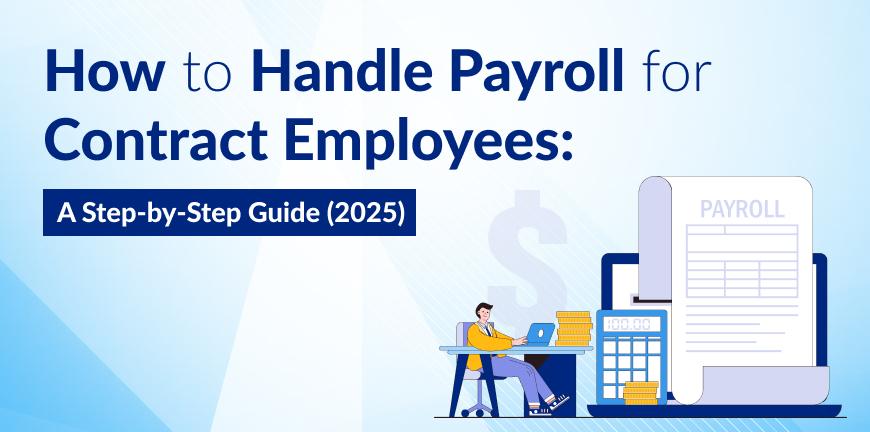
What is Contract labour? Advantages, Best Practices, Trends
02/05/2025
Understanding Labour Law and Industrial Law
06/05/2025In 2025, it is estimated that around 35% of the workforce will be made up of contract workers globally. However, to fully maximise the potential of the contract employees and ensure compliance, managing payroll for contract employees is critical. Let’s discuss how to handle the contract employee payroll process smartly by understanding what contract employment is, payroll processing steps, challenges, and best practices.
Who Are Contract Employees?
A contract employee is hired by a company or a contractor to perform a specific task or project for a fixed duration and compensation as agreed through an agreement or an official contract.
A freelancer, a consultant, or an individual with specific skills can be hired as a contract employee for an organisation. They are usually hired to support permanent employees in completing an urgent project or performing non-core activities that require unskilled or semiskilled workers.
The payroll for contract employees is usually managed by a contractor who hires them or a staffing agency with specialised expertise in payroll management.
A contract employee can be hired to perform blue-collared tasks like maintenance, security, delivery, etc., to highly specialised tasks like software development, content writing, app design, research, etc.
The key characteristics of contract employees are:
- They are hired for a limited duration to perform a task or a project and after completion, they are immediately relieved without notice.
- They are not entitled to benefits such as medical insurance, fixed salary, long term employment, etc., enjoyed by permanent employees
- The scope of work, duration, facilities and compensation are outlined by a contractual agreement.
- Their rights and dispute resolution are handled under the CLRA Act (Contract Labour (Regulation and Abolition) Act, 1970.
- Their tax withholdings and payroll records are usually managed by a contractor or a contract staffing agency.
Key Steps to Process Payroll for Contract Employees
Contract payroll meaning suggests that ” any individual hired by an organisation or a contractor will not come under direct payroll of the company rather a third-party agency or the contractors themselves will manage payroll tasks like payment disbursal, tax withholding, ESI and PF contributions, payslip generation, etc.
The payroll for contract employees varies slightly from permanent employees since they are hired for a short duration and the compliance requirements are different.
The key steps involved in contract employee payroll include:
1. Understand the difference between permanent and contract employees.
Before initiating contract employee payroll, it is essential to clearly understand the difference between permanent and contract employees. Firstly, contract employees work for a short duration and hence they can’t be integrated into the regular payroll system. A different payroll system must be created and the responsibility of managing it should be handed over to the contract staffing agency or the contractor.
Additionally, the compensation, tax withholdings, compliance laws, and other aspects are different for contract employees which must be taken into account while processing contract employee payroll.
2. Create a detailed contractual agreement
Before employing an individual or a team for contract employment, it is advised a to create comprehensive contractual agreement that clearly defines the roles and responsibilities of the contractor, the scope of work, payment terms, deadlines, facilities to be provided during the tenure, etc. This will reduce liabilities on the part of the company and ensure contractors comply with all the laws and regulations related to contract employment.
3. Decide the method of payment
Typically, contract employees are paid on an hourly basis, project basis, or duration basis, based on the type of work and the payment terms agreed on in the contract. Companies must decide the method of payment and process and manage the payroll accordingly.
4. Ensure tax responsibilities are handled appropriately
Usually, tax withholding responsibilities lie with the contractor, but the ultimate responsibility lies with the employer to ensure contractors have carried out the tax responsibilities as per regulations and paid the contract employees what they are promised in the agreement.
5. Deploy a seamless payroll and invoicing system
Companies must deploy a reliable payroll and invoicing system to ensure contractors pay the contract employees promptly as per the payroll contract and submit invoices regularly for verification. Companies must review the invoices and bank transactions to verify the payments and ensure payment and tax deductions are accurate and as per regulations.
6. Maintain Accurate records
Companies must maintain accurate records of every transaction and document related to payroll for contract employees for compliance and financial reporting. It will help companies prevent legal troubles and resolve payment disputes in case contracted employees are not paid on time or as per the agreed terms of the HR payroll contract.
7. Compliance with the CLRA Act
Companies must ensure that contractors comply with regulations and laws specified under the CLRA Act. Any violations in the contract employee payroll management must be identified and mitigated on an immediate basis to prevent legal disputes and improve the contract employee experience.
Common Payroll Challenges with Contract Workers
The common challenges encountered by companies during payroll for contract employees include:
1. Administrative complexity
One of the main challenges of managing contract employee payroll is to ensure the contractor is compliant with laws and regulations. Although most responsibilities lie with the contractor, any mistakes or violations can directly affect the company in terms of legal issues and damage to its brand reputation.
2. Compliance
Contract employee classification can be challenging, and any misclassification can lead to penalties and lawsuits.
3. Tracking working hours
For permanent employees, automatic attendance and leave tracking systems will be in place making it seamless for payment calculation. On the other hand, tracking the working hours is difficult since in most cases it will be manual leading to errors in payment calculation especially when the payroll contract works on hourly based payments.
4. Timely payment
Contract employee payroll must be executed separately as it’s not part of the regular payroll system, leading to payment delays, and compliance issues.
5. Maintaining accurate records
As the HR payroll contract is for a limited duration, an automatic record-keeping facility may not be feasible, and hence contractor or staffing agency has the responsibility of maintaining records from their end. The chances of errors and missing information are high since record-keeping might be done manually.
Best Practices for Contract Employee Payroll
The best practices to effectively manage payroll for contract employees include:
1. Choose a top contract staffing agency
Always choose a reputable contract staffing agency like ALP Consulting to engage in contract employment. As they have extensive experience and expertise in managing contract employees, companies can hand over the complete responsibility of managing payroll for contract employees and concentrate on their core activities.
2. Draft a comprehensive contractual agreement
Companies must draft a comprehensive contractual agreement outlining the roles and responsibilities of the contractor, payment terms, scope of work, duration, dispute resolution mechanism, prompt invoice and tax management, accurate record maintenance, etc. This will ensure contractors follow compliance requirements and pay the contract workers on time and the agreed compensation.
3. Accurate classification
Ensure contract employees are classified correctly, and a separate mechanism is implemented to maintain their records and other documentation.
4. Maintain accurate records and documentation
Companies must ensure accurate records and documentation of each activity and transaction are maintained throughout contract employment and beyond. It will act as a supporting document during the audit and proving compliance.
5. Develop a seamless contract employee payroll system
Establish a sales contract employee payroll system to ensure payments are done on time and records are maintained accurately. This will help create good relationships with contract employees and get better business outcomes.
6. Conduct Regular Audits and Ensure Compliance
Companies must conduct regular audits to identify, assess, and mitigate non-compliance issues with the contract employee payroll process. This will ensure accurate report generation and compliance with applicable laws and regulations.
Ways to Simplify Contract Payroll
Here are a few ways to simplify the process of payroll for contract employees:
1. Streamline Compliance
Companies must streamline the contract employee payroll management process from contract agreements to submitting compliance reports to government agencies to ensure compliance with regulations is achieved and contract workers receive payment on time with accurate tax withholdings and payslips.
2. Consolidate payroll schedules
Companies must ensure contractors pay their employees through a consistent payment schedule which will help improve employee experience and ensure records are maintained accurately based on timelines between each payment period.
3. Use a working hour tracking system
Although companies may not be able to integrate contract management into a regular employee attendance system, a reliable timecard app can be installed to track the working hours, sign-in and sign-out of contract workers. This move will help calculate accurate working hours and make payments accordingly.
4. Centralisation of contract employee payroll system
Creating an integrated onboarding, HR, and payroll system for managing contract employment can be very useful. Although this may increase the costs, in the long run, it will help companies ensure errors are prevented and the tax process is simplified.
Future Trends in Contractor Payroll
- Companies are exponentially increasing their contract workforce, and the trend will continue in 2025. To manage the large contract workforce, payroll for contract employees process must be streamlined to ensure timely payment and compliance.
- Diversity, Equity and Inclusion (DEI) initiatives apply to contract workforce as well and companies must modify their policies and payroll contract terms and conditions accordingly.
- Both central and state governments are making regulations more stringent to improve the lives of contract employees and both companies and contractors must make policy changes to remain compliant.
Frequently Asked Questions
1. What is a contract employee?
A contract employee is an individual hired by a company or a contractor to perform certain tasks related to a project for a specific duration and fixed compensation.
2. Is contract employee payroll more expensive?
Compared to permanent employment, contract employee payroll is less expensive. However, the skill level and quality of work may not be as good as permanent employees therefore more suitable for non-core activities.
3. Who is responsible for managing contract employee payroll?
Typically, a contractor or staffing agency manages payroll for contract employees, including payments, taxes, payslips, and compliance, though the hiring company must ensure these responsibilities are fulfilled properly.
4. Are contract employees entitled to employee benefits?
Contract employees are usually not entitled to benefits enjoyed by permanent employees. Their compensation, facilities, and other requirements are outlined in the contractual agreement signed before employment.
5. What laws govern contract employee compliance in India?
Contract employee rights and payroll compliance are primarily governed by the CLRA Act (Contract Labour (Regulation and Abolition) Act 1970), along with applicable labour and tax regulations.
Contact Us For Business Enquiry

Yugandhara V. M
Yugandhara V. M serves as the Assistant Vice President – HRO at Alp Consulting Ltd., bringing over 14 years of rich experience in Human Resource Outsourcing, payroll management, and statutory compliance. He specializes in driving process excellence across HR operations, ensuring seamless service delivery and compliance with labor laws. Yugandhara’s expertise lies in managing large-scale client engagements, optimizing HR processes, and implementing efficient workforce management systems that enhance organizational performance. He also leads comprehensive payroll services, ensuring accuracy, timeliness, and compliance for diverse client portfolios.




